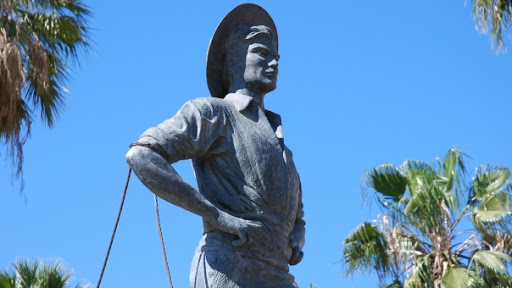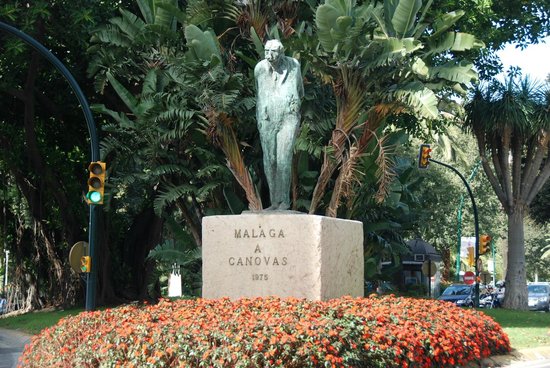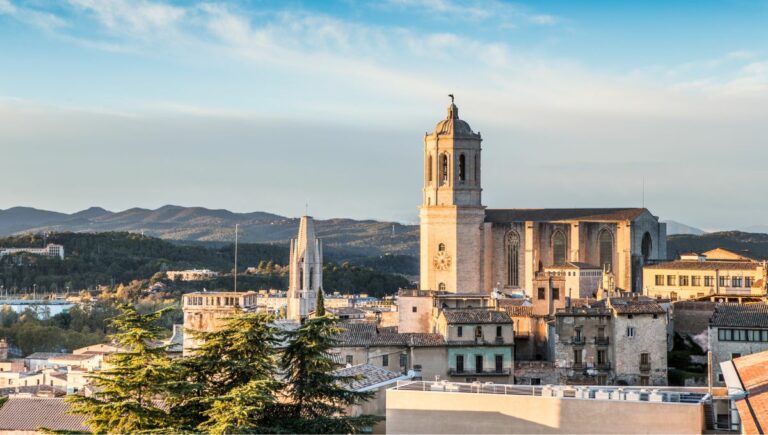A great way to explore any city is to find as many monuments and statues as possible and bring a little bit of the past to life. Spanish cities are full of them! Not only do they tell you about some of the city’s history, and usually the specific spot, but exploring and finding them is a great way to get some exercise.
Malaga is no different. A vibrant city steeped in centuries of history offers more than just a peek into its past; it invites you on a journey of discovery, where each monument and statue has a story. Some make sense, such as Pablo Picasso, one of Malaga’s most illustrious sons, but others do not, such as why Hans Christian Andersen is there in Malaga.
So join me on this whistle-stop tour and discover some of Malaga’s most important monuments and statues.
El Cenachero Statue

This bronze sculpture was made by the Malaga artist Jaime Fernández Pimentel in 1968. It represents a popular character from Malaga, the Cenachero, who sold fish through the city’s streets, maintaining the balance between the two cenachos (an item used to carry fish, meat, vegetables, or other food), hence its name.
The cenachos were made by hand with esparto, and they were filled on the beaches of the coast. They usually sold anchovies from Vitoria, but they also sold horse mackerel, sardines, or white shakers. In the sculpture, you can see how the traditional Cenachos were dressed: with a sash, the cenachos hung, and a hat to get relief from the sun.
As a result of Malaga’s twinning with the American city of Mobile in Alabama, Malaga City Council donated a replica sculpture that can be found in a square in the American city.
The Cenachero, together with the Biznaguero, which is in the Pedro Luis Alonso Gardens, and the Platero donkey, in the Malaga Park, form a trio of sculptures identified explicitly with the city and to which the citizens have great affection.
Find me here: Plaza de la Marina, 1, 29015 Málaga
Estatua de Hans Christian Andersen

A bronze work by the sculptor José María Córdoba commissioned by the Danish Royal Household presents the Danish writer sitting on a bench with a relaxed attitude. A scene that could perfectly reflect some of those moments that the writer of ‘The Little Mermaid’ or ‘The Ugly Duckling’ spent in the city during the first days of October 1862. Hans Christian Andersen also wrote many poems, novels, travelogues, and plays.
Captivated by the beauty of Malaga, by the sea, and its people, Andersen wrote that “in no other Spanish city have I ever felt so happy and comfortable as in Malaga.” The work invites you to come closer, sit next to the writer’s figure, admire and feel respect for his work, and appreciate his pioneering way of travelling as one of the first educated travellers of the 19th century.
Find me here: Plaza de la Marina, 4, 29015 Malaga
Estatua de Pablo Ruiz Picasso

Pablo Picasso’s Sculpture Portrait is dedicated to the iconic Malaga painter and sculptor Pablo Ruiz Picasso. It was made in bronze by Francisco López Hernández and represented the artist sitting on a marble bench with a notebook and a pencil. It was inaugurated on December 5th, 2008.
The work, located in Plaza de la Merced in the Centro district, sits in front of Picasso’s birthplace and the Picasso Foundation’s headquarters. Some consider it a historic site. The proportion of the figure is slightly higher than the actual height of Picasso.
In April 2013, a group of vandals tore the statue off its bench to take it away. However, due to the statue’s weight, they could not transport it very far, and it was found on a nearby bench.
You should read my Malaga City Guide for more information on the wonderful city.
Monumento a Torrijos

The monument to Torrijos was created in honour of José María de Torrijos y Uriarte. The obelisk was built in the Plaza de la Merced. Designed by architect Rafael Mitjana y Ardison, it is considered the most important and characteristic urban civil monument in Malaga from the 19th century.
It was conceived as a memorial to Torrijos and his 48 companions killed by gunfire between the San Andrés beach and the El Bulto neighbourhood on December 11th, 1831. The monument, built 11 years after the men’s slaughter, is located in the middle of the square and surrounded by a gate.
It consists of a crypt, where Torrijos’ remains have been placed, on which stands a pedestal with a square base, which in turn supports a slender pyramid of great height. The pyramid is decorated with a series of bronze laurel-shaped crowns on each of its four sides and another at the vertex. Each crown is dedicated to each of the forty-nine victims of the event.
Find me here: Plaza de la Merced
Larios Monument

The monument to the Marquis of Larios is an urban sculptural group dedicated to Manuel Domingo Larios y Larios, II Marquis of Larios. He was a senator of the Kingdom, entrepreneur and a Spanish aristocratic. He was the son of Martín Larios y Herreros, 1st Marquis of Larios, and of Margarita Larios y Martínez de Tejada, sister of Carlos Larios and Martínez de Tejada, 1st Marquis of Guadiaro.
The public sculpture made by Mariano Benlliure is considered the most relevant in the city. It is located at the intersection between Alameda Principal and Calle Larios, a symbolic place in the city.
Monument to Canovas del Castillo

Inaugurated on May 9th, 1975, this bronze sculpture is the Antequera artist Jesús Martínez Labrador’s work.
It is a tribute to the politician and historian author of the Manzanares Manifesto assassinated in 1897. He was a member of the Liberal Union and the greatest architect of the restoration, becoming the Conservative Party’s greatest leader that he himself created.
Find me here: Cánovas del Castillo Avenue, Malaga
Monumento a la Familia Galvez

The bronze sculpture dedicated to the Gálvez family was the work of Jaime F. Pimentel (also the author of El Cenachero). It was inaugurated on February 3rd, 2017.
It is a large monument located next to the Esplanade de la Estación fountain. It sits in front of the Hermanitas de los Pobres building and is just meters from the María Zambrano Renfe Station.
The work is made up of four statues. Three brothers José, Miguel and Matías de Gálvez, along with his son, Bernardo de Gálvez. It reflects the moment in time José de Gálvez, Minister of the Indies, who is seated, hands over to his nephew, viceroy of Mexico, Bernardo de Gálvez, the declaration of independence of the future United States of America.
This symbolic scene dated 1776 constitutes the beginning of a significant chapter in history. Bernardo de Gálvez channeled the aid of Spain to the thirteen American colonies. He triumphed over the British in the Mississippi, Mobila, and Pensacola. Due to these victories, King Carlos III gave Bernardo de Gálvez the title of Count of Gálvez.
These brilliant victories and his father’s defeat of the English in Guatemala proved to be decisive for the United States of America to achieve its independence in 1783. Matías and Bernardo de Gálvez served as viceroy of New Spain, whose capital is Mexico.
In the Franciscan Church of San Fernando, Bernardo de Gálvez’s remains rest today.
Manuel Agustin Heredia Monument

The Avenue Manuel Agustín Heredia is a road that runs west to east through the Spanish city’s downtown district in Malaga. It is an important communication route between the centre and the western part of the city that runs between the Ensanche Centro and the Port of Malaga.
At the union of the avenue with the Alameda de Colón is the monument in honour of Manuel Agustín Heredia, businessman and industrialist. The statue represents a serene but rugged Heredia, standing out on a parchment that carries Constantia et Labore’s message in his hand. With work and perseverance, anything can be achieved.
Juan Temboury Alvarez Statue

Juan Temboury Álvarez was an academic, researcher, and Spanish politician born in Malaga.
He was a profound student of the artistic and cultural heritage of the city of Malaga, dedicating himself mainly to the conservation of the Alcazaba but also participating in the restoration of the Buenavista Palace, the Basilica de la Victoria, the Episcopal Palace, the tower of Santiago, and the hermitage of Zamarrilla. Author of the historical-artistic monumental Catalog of Malaga and its province, he was decorated with the order of Alfonso X the Wise and a member of the San Fernando Academy of Madrid, the Royal Academy of Fine Arts of San Telmo, and the Royal Academy of History.
The initial idea for creating the Museo Picasso Malaga arose in 1953 from the contacts between Pablo Picasso and Juan Temboury, then Provincial Delegate of Fine Arts.
Monumento al Comandante Benítez

The monument to Comandante Benítez and the heroes of Igueriben is located on a pedestal in the park of the Spanish city of Malaga.
Its author is Julio González Pola. It was inaugurated on February 11th, 1926, by Alfonso XIII and Miguel Primo de Rivera (in one of the monarch’s multiple visits to the city). It paid tribute to Commander Julio Benítez y Benítez, hero of Igueriben, who participated in the defense of this position during the Rif War. That earned him the posthumously awarded the San Fernando Laureate Cross, which appears in relief on the pedestal.
It has a large white stone base with a soldier standing on top. The statue is made of a classic copper style, dressed in a military uniform and holding a saber; at his feet, an artillery piece rests.
Monumento al Marqués de Guadiaro

The monument to the Marqués de Guadiaro is a bust located on a pedestal in the Park in Malaga.
Its author is Mateu Fernández de Soto. It was inaugurated in 1906 and pays tribute to Carlos Larios y Martínez de Tejada, the 1st Marqués de Guadiaro, architect in the Larios family which was involved in the construction of Calle Marqués de Larios and Parque de Málaga.
It has a stone base with a staircase that serves as a fountain. On top of it a pedestal with symbolic motifs of commerce, industry, and Malaga. The crowning is the bronze bust. The environment was adapted by the architect Fernando Guerrero Strachan.
Monumento a Arturo Reyes

The monument to Arturo Reyes is a sculpture located in Parque de la Alameda, a park located in the centre of the Spanish city.
Its author is Adrián Risueño Gallardo, also a sculptor of the Fuente de las Tres Gitanillas. It was inaugurated in 1964 and paid tribute to the Malaga novelist and poet Arturo Reyes Aguilar. The monument consists of a bust with the writer’s image on a pedestal and a full-length woman standing in front of him.
Estatua Cardenal Ángel Herrera Oria

Ángel Herrera Oria was a Spanish journalist, a Roman Catholic politician, and later a cardinal.
He established the (foundation) Fundacion Pablo VI. It was named after Pope Paul VI and used to promote the Roman Catholic Church’s social doctrine. It was Pope Paul VI who promoted him to the rank of cardinal in 1965. Ángel founded several social initiatives and advocated for many apostolic and other social enterprises in his district and his sermons which were often a nationwide broadcast.
He founded the Leo XIII Social Institute and the Faculty of Arts of the Pontifical University of Salamanca at the Madrid campus. When his cause of canonization commenced, he was referred to as a Servant of God. Some people consider the monument a mini religious site due to everything he did for the Roman Catholic Church, it is a subjective opinion.



